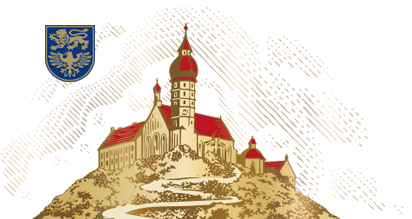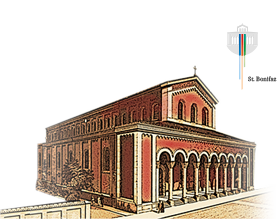The Andechs-Meranians
The name Andechs is first documented as “Andehse” in the year 1080. The castle-like compactness of today’s monastery complex serves as a reminder: This was the ancestral seat of the Counts of Andechs into the mid-13th century.
The origins of this famous family of counts are not known. Count Rasso who lived in the 10th century is a legendary ancestor. He is considered the founder of the Grafrath Monastery named after him, located on the northern bank of Ammersee lake, where he is also buried. According to lore, he acquired valuable relics of Christ and other sacred relics on a pilgrimage to the Holy Land. Relics of Christ are pieces of Christ’s crown of thorns, whips, reed sceptre and cross, and the Veil of Veronica. They became the basis of the Andechs collection of relics.
Rapid rise of the Counts of Dießen-Andechs
In 1128, Count Berthold II makes it mandatory for his subjects to undertake an annual pilgrimage to Andechs and to worship the relics kept there. He thereby establishes Bavaria’s oldest pilgrimage. In 1132, the family makes the Andechs Castle its headquarters, bearing the name Counts of Andechs henceforth. The three Sacred Hosts come to Andechs from Bamberg in 1179 – as a gift from Bishop Otto to his brother Berthold. The Counts of Andechs rose to become imperial princes thanks to their loyalty to the Staufers. They were among other things Dukes of Dalmatia, Croatia, Margraves of Istria (Merania) and Patriarchs of Aquileia. They founded cities such as Innsbruck, guarded important trade routes like the Brenner, they were the builders of the Bamberg Cathedral that stands to this day and held bishop’s sees. Numerous saints emerged from this noble family, including eminent women such as Saint Hedwig of Silesia and Saint Elisabeth of Thuringia.
Pinnacle of power and decline of the Andechs-Meranians
With the “Bamberg regicide” of 1208, the tide turns against the Counts of Andechs. At the wedding of Otto von Andechs to the niece of King Philipp of Swabia in Bamberg, Otto von Wittelsbach murders the king. Members of the House of Andechs are first accused of having perpetrated the offence, get banished as outcasts and lose their imperial fiefdom. Although the House of Andechs is exonerated from blame for the regicide in 1211, most of the property in southern Germany falls to the Wittelsbach family.
The Andechs castle is destroyed or falls into disrepair around the middle of the 13th century. Only the castle chapel dedicated to St. Nicholas remains. The Andechs collection of relics is thought to be lost. With the death of Otto II in 1248, the Counts of the House of Andechs die out in the male line.




